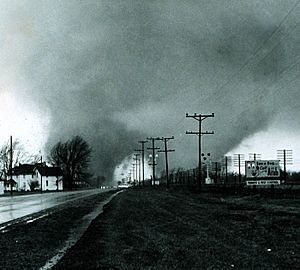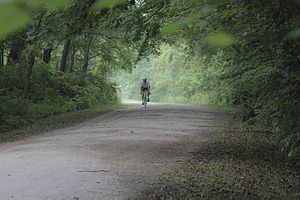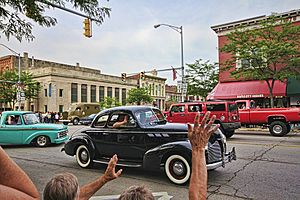Goshen, Indiana facts for kids
Quick facts for kids
Goshen, Indiana
|
|||
|---|---|---|---|
|
City
|
|||
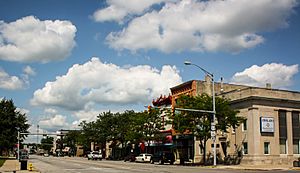
Downtown Goshen (2015)
|
|||
|
|||
| Nickname(s):
"The Maple City"
|
|||
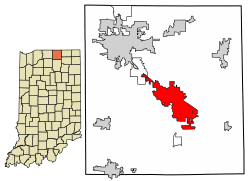
Location of Goshen in Elkhart County, Indiana.
|
|||
| Country | United States | ||
| State | Indiana | ||
| County | Elkhart | ||
| Area | |||
| • Total | 17.95 sq mi (46.50 km2) | ||
| • Land | 17.57 sq mi (45.52 km2) | ||
| • Water | 0.38 sq mi (0.98 km2) | ||
| Elevation | 801 ft (244 m) | ||
| Population
(2020)
|
|||
| • Total | 34,517 | ||
| • Density | 1,963.98/sq mi (758.28/km2) | ||
| Time zone | UTC−5 (EST) | ||
| • Summer (DST) | UTC−4 (EDT) | ||
| ZIP codes |
46526-46528
|
||
| Area code(s) | 574 | ||
| FIPS code | 18-28386 | ||
| GNIS feature ID | 0435227 | ||
| Website | goshenindiana.org | ||
Goshen (pronounced GOH-shun) is a city in Elkhart County, Indiana, United States. It is the main city of the Elkhart–Goshen area. This area is part of the larger South Bend–Elkhart–Mishawaka region. Goshen is in northern Indiana, close to the Michigan border. This area is often called Michiana.
Goshen is about 10 miles southeast of Elkhart. It is also about 25 miles southeast of South Bend. The city is 120 miles east of Chicago and 150 miles north of Indianapolis. In 2020, Goshen had a population of 34,517 people.
The city is well-known for making recreational vehicles (RVs) and their parts. It is also home to Goshen College, a small college. Goshen hosts the Elkhart County 4-H Fair, which is one of the biggest county fairs in the United States.
Contents
History of Goshen
Before European settlers arrived, the land where Goshen now stands was home to Native American tribes. These included the Miami people, the Peoria people, and Potawatomi peoples. They lived here for thousands of years.
In 1830, the U.S. Congress passed the Indian Removal Act. This law forced many Native American groups to move west of the Mississippi River.
Early Settlers and City Naming
Goshen was officially planned and laid out in 1831. It was named after the Land of Goshen, a fertile place mentioned in the Bible. The first settlers were mostly "Yankee" immigrants from New England. They were descendants of English settlers who came to New England in the 1600s.
Many New England families were large, with up to ten children. Land for farming became scarce in New England. Because of this, many Yankee settlers moved to the Midwestern United States.
Growth and Challenges
The building of the Erie Canal made it easier to travel to the Midwest. This led to more people moving from New England. The end of the Black Hawk War also made the area safer for settlers. However, this war also forced Native Americans, like the Potawatomi, to leave their homes.
The 1833 Treaty of Chicago set the rules for the Potawatomi to leave the Midwest. In 1837, they were forced to leave in what is now called the Potawatomi Trail of Death.
The early settlers were often part of the Congregational church. Many later joined the Methodist or Baptist churches. When these New Englanders arrived, the area was mostly thick forest and wild prairie. They built farms, roads, and government buildings.
Major Tornado Outbreak in 1965
On April 11, 1965, a huge series of tornadoes hit the Midwest. This day is known as Palm Sunday. Two very strong tornadoes caused a lot of damage near Goshen. They hit the Midway Trailer Park and the Sunnyside Housing Addition. Another strong tornado also struck parts of southeast Goshen.
Across Indiana, 137 people died in these storms. Fifty-five of those deaths were in Elkhart County. A few days later, President Lyndon B. Johnson visited the damaged areas.
Historic Places and Community Events
The Goshen Historic District was added to the National Register of Historic Places in 1983. This district includes many old buildings and the Elkhart County Courthouse.
In April 2006, Goshen was the site of a large march for immigration rights. Officials estimated that 2,000 to 3,000 people marched to the County Courthouse.
Goshen has been called a "sundown town" in the past. This meant that African Americans were supposedly not allowed to live in or enter the town after dark. There was no official law for this. However, in March 2015, the city formally apologized for past racial discrimination. A documentary called "Goshen: A Sundown Town's Transformation" tells this story.
Several important buildings in Goshen are listed on the National Register of Historic Places. These include the Elkhart County Courthouse, the Fort Wayne Street Bridge, and the Goshen Carnegie Public Library.
Geography and Climate
Goshen is located at 41°34′55″N 85°50′12″W / 41.58194°N 85.83667°W. The Elkhart River flows through the city. It forms the Goshen Dam Pond on the south side. Rock Run Creek also runs through town. Main Street divides the city east and west, and Lincoln Avenue divides it north and south.
The city covers about 16.59 square miles (43 square kilometers). Most of this area, about 16.23 square miles (42 square kilometers), is land. The rest, about 0.36 square miles (0.93 square kilometers), is water.
Environmental Efforts
In February 2018, the Elkhart River flooded badly due to heavy rain and melting snow. The river reached a record height of 13.2 feet. This flood damaged over 300 buildings and forced people to leave their homes.
The city government is working to deal with more severe weather, like floods and heavy rains. They are improving stormwater management. They also have a plan to increase the city's tree canopy by 45%. In 2019, Goshen completed 92 solar projects. The city produced 116 watts of solar power per person in 2019. This was more than many larger cities like Phoenix and Los Angeles.
Weather Patterns
Goshen has a climate with four distinct seasons. Summers are warm and humid, while winters are cold with snow. Spring and autumn are mild. The city gets a good amount of rain throughout the year. Snowfall is common in winter months.
| Climate data for Goshen, Indiana (1991–2020 normals, extremes 1914–present) | |||||||||||||
|---|---|---|---|---|---|---|---|---|---|---|---|---|---|
| Month | Jan | Feb | Mar | Apr | May | Jun | Jul | Aug | Sep | Oct | Nov | Dec | Year |
| Record high °F (°C) | 68 (20) |
73 (23) |
87 (31) |
88 (31) |
95 (35) |
104 (40) |
111 (44) |
106 (41) |
101 (38) |
90 (32) |
80 (27) |
69 (21) |
111 (44) |
| Mean maximum °F (°C) | 52.9 (11.6) |
56.0 (13.3) |
70.1 (21.2) |
79.7 (26.5) |
87.0 (30.6) |
92.1 (33.4) |
92.4 (33.6) |
90.7 (32.6) |
89.2 (31.8) |
81.4 (27.4) |
67.3 (19.6) |
55.2 (12.9) |
94.2 (34.6) |
| Mean daily maximum °F (°C) | 31.7 (−0.2) |
35.5 (1.9) |
47.2 (8.4) |
60.3 (15.7) |
71.7 (22.1) |
80.4 (26.9) |
83.3 (28.5) |
81.3 (27.4) |
75.2 (24.0) |
62.8 (17.1) |
48.4 (9.1) |
36.5 (2.5) |
59.5 (15.3) |
| Daily mean °F (°C) | 24.7 (−4.1) |
27.9 (−2.3) |
38.0 (3.3) |
49.5 (9.7) |
60.8 (16.0) |
70.0 (21.1) |
73.1 (22.8) |
71.3 (21.8) |
64.5 (18.1) |
53.0 (11.7) |
40.6 (4.8) |
30.1 (−1.1) |
50.3 (10.2) |
| Mean daily minimum °F (°C) | 17.8 (−7.9) |
20.2 (−6.6) |
28.8 (−1.8) |
38.7 (3.7) |
49.9 (9.9) |
59.6 (15.3) |
62.8 (17.1) |
61.3 (16.3) |
53.9 (12.2) |
43.3 (6.3) |
32.8 (0.4) |
23.7 (−4.6) |
41.1 (5.1) |
| Mean minimum °F (°C) | −4.6 (−20.3) |
0.2 (−17.7) |
10.4 (−12.0) |
23.6 (−4.7) |
34.8 (1.6) |
45.2 (7.3) |
50.9 (10.5) |
49.8 (9.9) |
39.4 (4.1) |
29.1 (−1.6) |
18.3 (−7.6) |
4.3 (−15.4) |
−8.6 (−22.6) |
| Record low °F (°C) | −25 (−32) |
−21 (−29) |
−19 (−28) |
1 (−17) |
24 (−4) |
32 (0) |
39 (4) |
37 (3) |
25 (−4) |
16 (−9) |
−5 (−21) |
−25 (−32) |
−25 (−32) |
| Average precipitation inches (mm) | 2.78 (71) |
2.33 (59) |
2.44 (62) |
3.79 (96) |
4.27 (108) |
4.12 (105) |
3.99 (101) |
4.05 (103) |
3.27 (83) |
3.33 (85) |
2.96 (75) |
2.52 (64) |
39.85 (1,012) |
| Average snowfall inches (cm) | 13.8 (35) |
11.4 (29) |
5.4 (14) |
1.2 (3.0) |
0.0 (0.0) |
0.0 (0.0) |
0.0 (0.0) |
0.0 (0.0) |
0.0 (0.0) |
0.1 (0.25) |
3.4 (8.6) |
9.9 (25) |
45.2 (115) |
| Average precipitation days (≥ 0.01 in) | 13.4 | 11.2 | 10.8 | 12.0 | 11.7 | 10.9 | 10.1 | 9.8 | 9.1 | 11.2 | 11.5 | 12.3 | 134.0 |
| Average snowy days (≥ 0.1 in) | 10.4 | 8.6 | 4.3 | 1.0 | 0.0 | 0.0 | 0.0 | 0.0 | 0.0 | 0.2 | 2.8 | 7.3 | 34.6 |
| Source: NOAA | |||||||||||||
People of Goshen
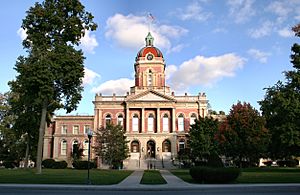
The population of Goshen has grown steadily over the years.
| Historical population | |||
|---|---|---|---|
| Census | Pop. | %± | |
| 1850 | 780 | — | |
| 1860 | 2,053 | 163.2% | |
| 1870 | 3,133 | 52.6% | |
| 1880 | 4,123 | 31.6% | |
| 1890 | 6,033 | 46.3% | |
| 1900 | 7,810 | 29.5% | |
| 1910 | 8,514 | 9.0% | |
| 1920 | 9,525 | 11.9% | |
| 1930 | 10,397 | 9.2% | |
| 1940 | 11,375 | 9.4% | |
| 1950 | 13,003 | 14.3% | |
| 1960 | 13,718 | 5.5% | |
| 1970 | 17,871 | 30.3% | |
| 1980 | 19,665 | 10.0% | |
| 1990 | 23,797 | 21.0% | |
| 2000 | 29,383 | 23.5% | |
| 2010 | 31,719 | 8.0% | |
| 2020 | 34,517 | 8.8% | |
| U.S. Decennial Census 2010–2020 | |||
Population in 2020
In 2020, Goshen had 34,517 residents. The city is becoming more diverse. About 58% of residents were White (not Hispanic). About 3% were Black or African American. About 1.4% were Asian. People of two or more races made up about 3% of the population.
A significant part of the population, about 33.75%, identified as Hispanic or Latino. This group can be of any race.
Population in 2010
In 2010, Goshen had 31,719 people. There were 11,344 households in the city. About 36% of households had children under 18 living there.
The average age in Goshen was 32.4 years. About 27% of residents were under 18 years old. About 15% were 65 years or older. The city's population was almost evenly split between males (48.9%) and females (51.1%).
Economy and Jobs
Goshen's economy is mainly focused on the automotive and recreational vehicle (RV) industries. Many companies here make parts for cars and RVs. Other companies build custom bodies onto vehicle frames.
Some RV manufacturing companies, like Dutchmen and Forest River, are located in Goshen. These industries provide many jobs for the city's residents.
Education in Goshen
Goshen Community Schools serves most of the city. This school system includes six elementary schools. It also has Goshen Intermediate School, Goshen Junior High School, and Goshen High School.
In 2012, U.S. News & World Report ranked Goshen High School as one of the best in Indiana. It was in the top 6% of high schools nationwide.
Other school districts also cover small parts of Goshen. These include Middlebury Community Schools and Concord Community Schools.
Bethany Christian Schools is a private Christian school in Goshen. It serves students from grades 4 to 12.
Goshen College is located on the south side of town. It has about 773 students. The college is known for its strong academic programs.
The city also has a free public library, the Goshen Public Library.
Transportation Options
Air Travel
Goshen Municipal Airport is a public airport. It is located about 3.5 miles southeast of downtown Goshen. The Goshen Board of Aviation Commissioners owns and operates the airport.
For commercial flights, the closest airports are South Bend International Airport (about 36 miles away) and Fort Wayne International Airport (about 61 miles away). O'Hare International Airport in Chicago is about 141 miles away.
Bus Services
The Interurban Trolley bus system connects Goshen to nearby cities. You can take a bus to Elkhart and Dunlap. These routes pass by Elkhart's Amtrak station. This allows people to connect to long-distance trains like the Capitol Limited.
Bus riders can also transfer to other routes. These routes connect to Elkhart's Greyhound bus station. They also go to the city of Mishawaka and the town of Osceola. From Mishawaka, you can connect to the TRANSPO bus system. This system takes you to places throughout the South Bend-Goshen area. You can also connect to the South Shore Line train at South Bend International Airport.
Fun and Recreation
Goshen has seven parks for outdoor activities. There are also several greenways and trails throughout the city. One trail follows the old Mill Race and hydraulic canal. This canal once powered an old hydroelectric power plant. There are plans to reopen the plant and develop the area around the canal.
The Pumpkinvine Nature Trail starts northeast of Goshen at Abshire Park. It runs from Goshen to Middlebury and Shipshewana. This trail is a popular spot for walking, running, and biking. The Maple City Greenway and the Millrace trail also offer many miles of easy-to-access paths.
The Elkhart County Fairgrounds are in Goshen. The Elkhart County 4-H Fair is held there every July. It is the largest county fair in Indiana. It is also one of the biggest 4-H County Fairs in the United States.
The Goshen Air Show is an annual event. It takes place at the Goshen Municipal Airport.
Since 2007, Downtown Goshen, Inc. has hosted a "First Fridays" program. On the first Friday of each month, stores stay open late. There is also music, entertainment, and other events in downtown Goshen.
Culture and Local Facts
The Wal-Mart on the south side of Goshen is said to be the first Wal-Mart in the U.S. to have a covered stable. This stable was built for its many Amish customers. The Amish built the stable using materials donated by Wal-Mart.
The movie Lonesome Jim (2005) was filmed in Goshen. It was written by James Strouse, who used to live in Goshen. The movie starred Liv Tyler and Casey Affleck.
Notable People from Goshen
Many interesting people have come from Goshen, Indiana.
Mayors of Goshen
| Name | Term | End Date | Pol. Party |
|---|---|---|---|
| Henry Daniel Wilson | May 1868 | May 1869 | Dem. |
| Melvin Barnes Hascall | May 1869 | May 1871 | |
| Joseph A S Mitchell | May 1871 | May 1873 | Dem. |
| George Freese Sr | May 1873 | May 1875 | Republ., Prohibitionist |
| Charles Bidwell Alderman | 1875; 1877; 1879; | May 1882 | Dem. |
| Philemon Doud Harding | May 1882 | May 1884 | Dem. |
| Josiah B. Cobb | May 1884 | May 1886 | Republi. |
| Philemon Doud Harding | 1886 See Above | May 1888 | Dem |
| Charles Wesley Miller | May 1888 | May 1890 | Republ. |
| John H. Lesh | May 1890 | May 1892 | Republ. |
| John B. Walk | May 1892 | Sept 1894 | Republ. |
| Dr Joseph H Heatwole | 1894; 1896 | July 1898 | Republ. |
| Benjamin F Deahl | Filled Unexpired term (July 1898 – May 1900); 1900–1902 | May 1902 | Dem. |
| George Finely Alderman | 5/1/1902 | May.1904 | Dem. |
| Alfred Lowry | 1/1/1904 | Dec. 1906 | Republ. |
| Charles Kohler | 1/1/1906 | Dec. 1908 | Dem. |
| Samuel Franklin Spohn | 1/1/1909 | Dec. 1918 | Dem. |
| Daniel Jackson "DJ" Troyer | Jan. 1918 | Apr. 1919 | Republ. |
| William Herbert Charnley | Apr. 1919 | Dec. 1918 | Republ. |
| George R. Rimpler | Jan. 1922 | Dec. 1925 | Dem. |
| John Orrien Abshire | Jan. 1926 | Dec. 1929 | |
| Clell Eugene Firestone | Dec. 1930; 1934 | Dec. 1938 | Dem. |
| Gordon Douglas Pease | Jan. 1938 | Dec. 1942 | Republ. |
| Frank S. Ebersole | Jan. 1943 | Dec. 1947 | Republ. |
| Rollin Richard Roth Sr | Jan. 1948 | Dec. 1955 | Republ. |
| Ray Bernard Messick | Jan. 1956–59 | Dec. 1963 | |
| Ralph Bowman Schenk | Jan. 1964; 1968; | Dec. 1975 | Republ. |
| Steven Regis Chisick | Jan. 1976 | Dec. 1979 | Dem. |
| Max Ronald Chiddister | Jan. 1980 | Dec. 1987 | Republ. |
| Michael S. Puro | Jan. 1988 | Mar.1997 | Dem. |
| Allan J. Kauffman | Apr. 1997 | Dec. 2015 | Dem. |
| Jeremy P. Stutsman | Jan. 2016 | Jun. 2023 | Dem. |
| Gina M. Leichty | Jun. 2023 | Dem. |
Politicians from Goshen
- John Baker, a U.S. Representative from Indiana.
- Ebenezer M. Chamberlain, another U.S. Representative from Indiana.
- Joseph Hutton Defrees, also a U.S. Representative from Indiana.
- Charles W. Miller, who was Indiana's Attorney General and a mayor of Goshen.
- Joseph Mitchell, a judge on the Indiana Supreme Court and the third mayor of Goshen.
Entertainment Figures
- James Carew, a silent film actor.
- Howard Hawks, a famous film director.
- Kenneth Hawks, also a film director.
- Philip Proctor, a comedian and actor known for Firesign Theatre.
- Raymond L. Schrock, a screenwriter.
- Tim Showalter, a musician.
- James C. Strouse, a screenwriter.
- Jordon Hodges, an actor.
- Lotus, a band that formed at Goshen College.
Sports Personalities
- Shek Borkowski, a coach for the Haiti national soccer team.
- Rick Mirer, a quarterback in the NFL.
- Patricia Roy, an AAGPBL baseball player and IHSAA commissioner.
- Doug Weaver, a college football player and head coach.
- Justin Yoder, a soap box racer.
Other Notable People
- Ida Shepard Oldroyd, a conchologist (someone who studies shells) and museum curator.
- Lois Gunden, recognized as a Righteous Among the Nations for helping people during the Holocaust.
- Kate Bolduan, a news anchor for CNN.
Sister Cities
Goshen has two sister cities. These are cities that partner with each other to promote cultural ties.
Images for kids
See also
 In Spanish: Goshen (Indiana) para niños
In Spanish: Goshen (Indiana) para niños




